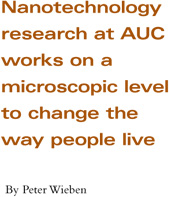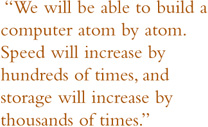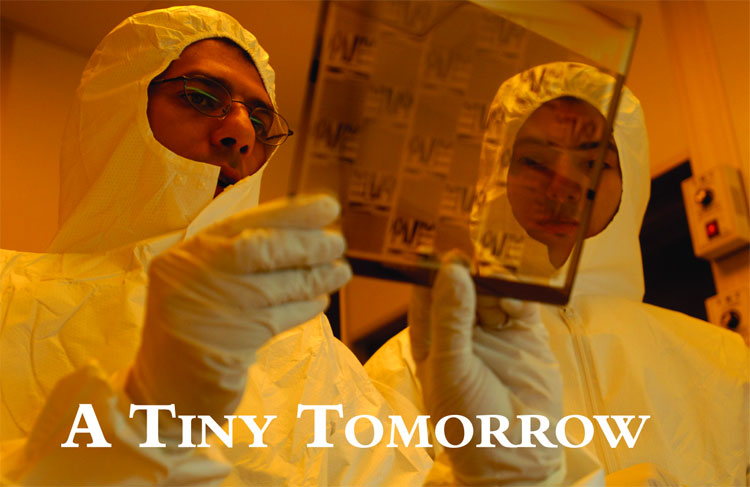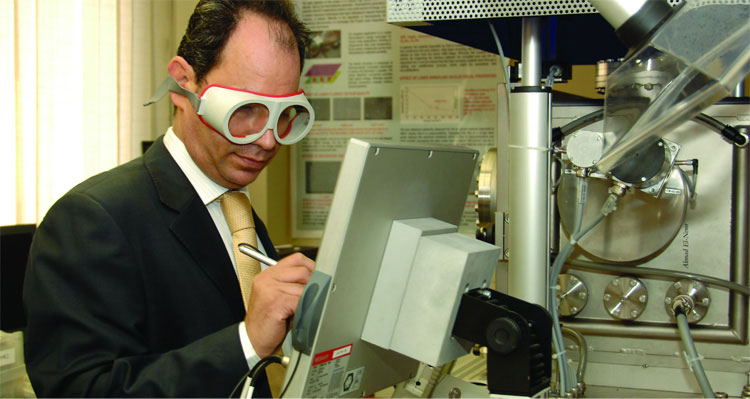|
 Imagine a laboratory the size of your watch that you can wear every day. By taking small blood samples, it will be able to analyze your whole body and wirelessly send the information to your doctor. Now, imagine going in for surgery and having a microscopic robot injected into your arm through a syringe, then having the robot perform the surgery from within your body without making an incision. Although this may sound like science fiction, such procedures may be possible within 20 years, thanks in part to the research being conducted at AUC’s Yousef Jameel Science and Technology Research Center (STRC). Imagine a laboratory the size of your watch that you can wear every day. By taking small blood samples, it will be able to analyze your whole body and wirelessly send the information to your doctor. Now, imagine going in for surgery and having a microscopic robot injected into your arm through a syringe, then having the robot perform the surgery from within your body without making an incision. Although this may sound like science fiction, such procedures may be possible within 20 years, thanks in part to the research being conducted at AUC’s Yousef Jameel Science and Technology Research Center (STRC).
Established in 2003 as a result of the generous support of Yousef Jameel ’68, the STRC supports a variety of nanoscience and technology-oriented projects. Bringing together internationally renowned and published scientists from around the world, the center employs state-of-the-art equipment in the physical sciences and engineering. Its research activities encompass five main areas: microfabrication, structured nanomaterial, surface chemistry, biotechnology, and environmental science and engineering. Taking a multidisciplinary approach and fostering the transfer of knowledge through a variety of partnerships, the STRC is poised to develop AUC as a premier center for scientific research regionally and globally.
With nanotechnology –– the science of the very, very small –– big steps are being taken at the STRC to understand a tiny world invisible to the naked eye. Scientists at AUC are hopeful that knowledge of nanotechnology will mean progress, changing the way we live our lives.
To understand what scientists at AUC are doing with nanotechnology, one has to visualize how small a nanometer is. Technically speaking, a nanometer is 1 x 10-9 meters, or one one-billionth of a meter long. Imagine holding a ball one nanometer across, and comparing it to a soccer ball. The nanoball is to a soccer ball as a soccer ball is to Earth.
In fact, nanometers are so incredibly small that professors working on the nanoscale are looking at a world most people simply would not recognize. They are able to tinker with the very building blocks of matter, influencing the molecular structures of materials and constructing miniscule devices atom by atom. These devices, commonly referred to as microelectromechanical (MEMS) and nanoelectromechanical (NEMS) systems, may soon make computers faster, cars cleaner and bodies healthier. Sherif Sedky, associate professor of physics who holds 11 patents on microscopic devices, is working on techniques that could one day be responsible for a dizzying array of new gadgets, as well as improvements to familiar technologies such as mobile phones. “The field is only 15 years old, but nearly every system you can think of has some MEMS component in it, from pharmaceuticals and mobile phones to the wing of an airplane and the fabric of your stain-resistant shirt,” Sedky said.
To produce devices on the nanoscale, there are two main techniques. The technique currently used by Sedky, the top-down approach, allows scientists to build small devices using larger tools. To create a shape at the nanoscale, he starts with a very thin film and trims it to the desired shape using photolithography and chemical etching. By stacking these films layer upon layer, he is able to create two- and three-dimensional shapes that can then be used to perform tasks at the microscopic level.
 The other technique is called the bottom-up approach, in which molecules are literally pieced together one by one. “We will be able to build a computer atom by atom,” Sedky said. “Speed will increase by hundreds of times, and storage will increase by thousands of times.” The other technique is called the bottom-up approach, in which molecules are literally pieced together one by one. “We will be able to build a computer atom by atom,” Sedky said. “Speed will increase by hundreds of times, and storage will increase by thousands of times.”
Sedky’s projects are smaller than a dust mite, but they take an incredible amount of precision and dedication to build. Despite the obvious challenges of constructing a working device the size of a human cell, Sedky noted that working on such tiny scales places special demands on him as an engineer. “Things are different on this small of a scale; you have to take account of everything,” he said.
From the time Sedky comes up with an idea for a device, the process of creating MEMS can last for more than four years, as the fabrication itself is a delicate procedure. “The construction phase alone can take anywhere from six months to a year,” Sedky said. In addition, before building a MEMS device, Sedky puts his ideas through elaborate simulations to prevent complications.
At the STRC, Sedky finds the tools he needs to approach all these issues. These include the lasers needed to prepare the thin film and tune its physical properties, the lithography and chemicals required to trim components into the proper shapes, the electron microscope for viewing it all, and a clean room where flecks of dust –– which are like boulders on the microscale –– are kept at bay. “There are lots of devices here that make what we do possible,” Sedky said.
If a specific task can’t be completed in Cairo, the STRC provides AUC’s scientists with an excellent opportunity to collaborate with other experts around the world. “Our equipment complements what you would find at other institutions,” Sedky said. “This was intentional; it helps us promote a lot of collaboration with other labs. This is the kind of applied research Egypt and the region needs.”
The STRC exemplifies positive collaboration in the transfer of technology through its partnership with the Nanoscience Centre at the University of Cambridge. Mark Welland, director of Cambridge’s Interdisciplinary Research Collaboration in Nanotechnology, has been associated with the center since its establishment and continues to be closely involved in various aspects of its activities. The STRC is also engaged in collaborative research with the Interuniversity Microelectronics Center in Belgium, where specialized and more intricate fabrication work can be done, and the National Research Center in Egypt.
Sedky believes the work being conducted at the STRC will be part of a new generation of nanodevices that have the potential to alter people’s lifestyles. Such devices include “smart bricks” with tiny sensors that can analyze building safety and warn of fires or earthquakes. These same sensors can be placed in and around cars, helping airbags deploy properly, warning of low tire pressure, and sensing objects around a car, all while being invisible and consuming only negligible amounts of power. “These devices will change the way we live,” Sedky said.
The ideas for such devices often come from problems scientists encounter in their communities. Ehab Abdel Rahman, visiting assistant professor of physics, thinks his work may one day be used as part of a remedy for Cairo’s chronic pollution problem. “We are working toward using hydrogen as fuel. It’s incredibly clean; its only byproducts are water, heat or energy; and it’s efficient,” he said. However, using hydrogen to power cars that operate on current technology would be unwieldy, if not outright dangerous. “Storing hydrogen as a gas would require a tank as big as the car itself,” Abdel Rahman explained, “and it is risky to store hydrogen as a gas or liquid.” To overcome these pitfalls, Abdel Rahman is using nanotechnology to create a solid material able to safely hold hydrogen at high concentrations.
“Think of it as a hydrogen sponge,” Abdel Rahman explained. “You would pull up to a hydro station, and it would take you about 15 seconds to fill your tank; it would be that fast. What would actually be happening is that you would be pumping hydrogen onto this sponge inside your car, and as soon as it is saturated, you would have enough fuel to run the car.
Fuel is not the only application Abdel Rahman has found for nanotechnology. Working with his colleague Amr Shaarawi, physics professor, he also studies phototenic crystals, tiny bits of material that control beams of light. These could one day be assembled into computer components much faster and smaller than their current relatives. Today’s computers “think” in electrons, or small doses of electricity, but using the light logic gates Abdel Rahman and Shaarawi are hoping to design, companies could theoretically build optical computers capable of transferring information much faster than an electron can travel through a wire. Built on the nanoscale, optical computers would be much lighter and smaller than today’s laptops.
While an optical PC may be a thing of the future, Abdel Rahman noted that the phototenic crystals could be noticeable around AUC within a few years. “We are working on the development of smart windows that allow heat in during the winter and keep it out during the summer,” he said.
Abdel Rahman explained that in the winter, when the sun is at a lower angle in the sky, the transparent filter would allow infrared light (the light that causes heat) to pass through it. In the summer, when the angle changes, the filter would keep the infrared light out. “In theory, we could warm classrooms in the winter and keep them cool in the summer just by adding a microscopic layer of nanofilters to our windows,” he said.
“Students are getting excited,” added Sedky, who says that many students who would have studied nanotechnology abroad in the past are now staying at AUC to work at the STRC. “They are going to leave with lots of experience in what they are doing, and this is a very exciting time for nanotechnology worldwide.”
Sharing Sedky’s passion, Joumanna El Rifai, a graduate student and research assistant, works on optics in the STRC, constructing lenses on the nanoscale. “The great thing about the STRC is that it brings people together from a variety of disciplines,” she said. “I can see nanotechnology at AUC going anywhere because it involves so many fields and so many talented people. There are the optics that I do, the obvious applications in physics and chemistry, and it can have a huge impact in biology as well. You can even use nanotechnology in cancer detection; things are getting smaller and smaller everyday.”
In the STRC, however, the impact of nanotechnology seems only to be growing.
|
Abdel Rahman monitors the work of a pulsed laser deposition system as it prepares the alloys used to store hydrogen
|
|

 Imagine a laboratory the size of your watch that you can wear every day. By taking small blood samples, it will be able to analyze your whole body and wirelessly send the information to your doctor. Now, imagine going in for surgery and having a microscopic robot injected into your arm through a syringe, then having the robot perform the surgery from within your body without making an incision. Although this may sound like science fiction, such procedures may be possible within 20 years, thanks in part to the research being conducted at AUC’s Yousef Jameel Science and Technology Research Center (STRC).
Imagine a laboratory the size of your watch that you can wear every day. By taking small blood samples, it will be able to analyze your whole body and wirelessly send the information to your doctor. Now, imagine going in for surgery and having a microscopic robot injected into your arm through a syringe, then having the robot perform the surgery from within your body without making an incision. Although this may sound like science fiction, such procedures may be possible within 20 years, thanks in part to the research being conducted at AUC’s Yousef Jameel Science and Technology Research Center (STRC). The other technique is called the bottom-up approach, in which molecules are literally pieced together one by one. “We will be able to build a computer atom by atom,” Sedky said. “Speed will increase by hundreds of times, and storage will increase by thousands of times.”
The other technique is called the bottom-up approach, in which molecules are literally pieced together one by one. “We will be able to build a computer atom by atom,” Sedky said. “Speed will increase by hundreds of times, and storage will increase by thousands of times.”